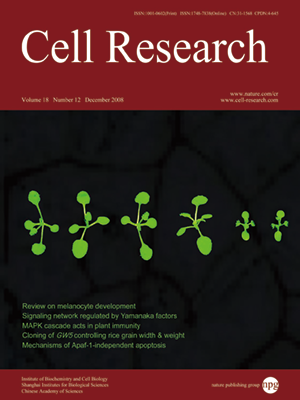
Volume 18, No 12, Dec 2008
ISSN: 1001-0602
EISSN: 1748-7838 2018
impact factor 17.848*
(Clarivate Analytics, 2019)
Volume 18 Issue 12, December 2008: 1199-1209
ORIGINAL ARTICLES
Isolation and initial characterization of GW5, a major QTL associated with rice grain width and weight
Jianfeng Weng1, Suhai Gu2, Xiangyuan Wan1, He Gao1, Tao Guo1, Ning Su2, Cailin Lei2, Xin Zhang2, Zhijun Cheng2, Xiuping Guo2, Jiulin Wang2, Ling Jiang1, Huqu Zhai2 and Jianmin Wan2
1National Key Laboratory for Crop Genetics and Germplasm Enhancement, Nanjing Agricultural University, Nanjing 210095, China
2Institute of Crop Science and the National Key Facility for Crop Gene Resources and Genetic Improvement, Chinese Academy of Agricultural Sciences, Beijing 100081, China
Correspondence: Jianmin Wan,(wanjm@caas.net.cn)
Grain weight is a major determinant of crop grain yield and is controlled by naturally occurring quantitative trait loci (QTLs). We earlier identified a major QTL that controls rice grain width and weight, GW5, which was mapped to a recombination hotspot on rice chromosome 5. To gain a better understanding of how GW5 controls rice grain width, we conducted fine mapping of this locus and uncovered a 1 212-bp deletion associated with the increased grain width in the rice cultivar Asominori, in comparison with the slender grain rice IR24. In addition, genotyping analyses of 46 rice cultivars revealed that this deletion is highly correlated with the grain-width phenotype, suggesting that the GW5 deletion might have been selected during rice domestication. GW5 encodes a novel nuclear protein of 144 amino acids that is localized to the nucleus. Furthermore, we show that GW5 physically interacts with polyubiquitin in a yeast two-hybrid assay. Together, our results suggest that GW5 represents a major QTL underlying rice width and weight, and that it likely acts in the ubiquitin-proteasome pathway to regulate cell division during seed development. This study provides novel insights into the molecular mechanisms controlling rice grain development and suggests that GW5 could serve as a potential tool for high-yield breeding of crops.
Cell Research (2008) 18:1199-1209. doi: 10.1038/cr.2008.307; published online 18 November 2008
FULL TEXT | PDF
Browse 2176


